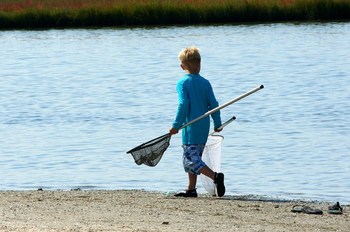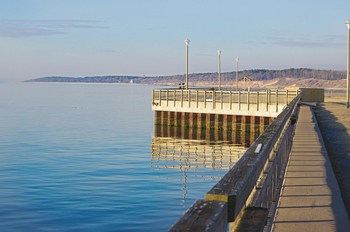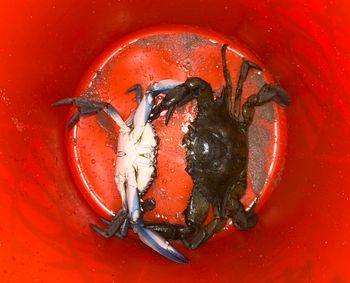How To Go Crabbing With Ring Nets (For Blue Crabs)
Sometimes called a hoop net, or just a net, ring nets are one of my favorite ways to go crabbing that’s perfect for the beginner crabber. They work on a boat, pier, or even a shoreline. It’s an easy method anyone young and old can enjoy with ZERO prior experience! Let’s dive into how to use
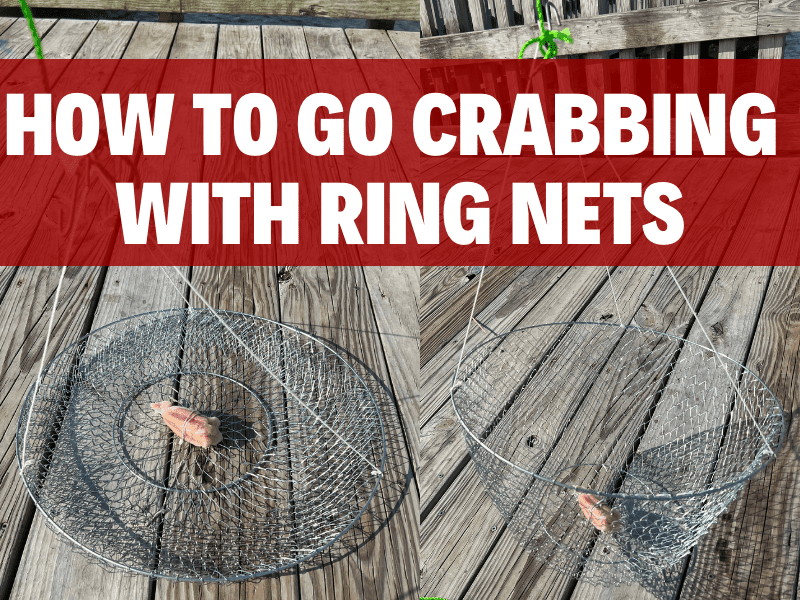
Quick Summary
- Buy a Ring Net from your local bait and tackle store, Walmart, Cabela’s, Bass Pro Shop, or even Amazon.
- Find a pier with water 4 – 20 feet deep, and wait until a day with calm waters and fair weather.
- Secure your preferred bait to the center of the net.
- Secure a strong line to your net’s harness, then throw off a pier or boat. Pull your net every 5-10 minutes.
- Keep crabs that meet your state’s criteria in a cooler or bucket. Place a damp towel inside or over your container and an ice pack to keep the crabs cool.
Step 1) Gather a few ring nets, bait, and a bucket or cooler to hold your crabs.
When I’m using ring nets, I always bring the following:
- A Ring Net & Rope
- Bait
- A Bucket or Cooler
- Tongs (optional)
- A Good Book (optional)
1) Ring Net
In this article, I use two variations of the ring net. I’ll quickly go over my experience with both and which I recommend you use.
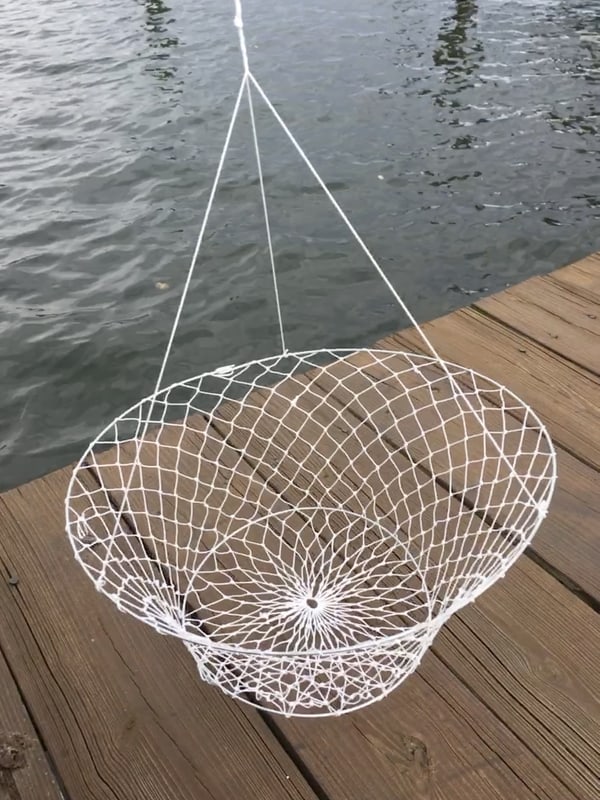

The cotton-mesh ring net was the unbranded, cheaper option of the two. I found it at Walmart in the fishing section and gave it a try. I found that it was flimsy and the cotton mesh will wear away after a few uses. After using it a few times, this net got caught on something in the water and ripped the net right open. Overall, I had a pretty negative experience with this trap.
The Hurricane wire-mesh trap, on the other hand, is built to last. I’ve used it several times in the water, and it lives up to my standards. The only thing I would critique is the harness, as it comes with a cheap “S” ring and cotton straps. It also has no built-in bait holder, but that’s just me being picky.
If you decide you want to use the Hurricane Ring Net, Click here to check the current price on Amazon.com (Affiliate Link, Crabbinghub will receive a small commission for your purchase at no extra cost to you. Thank you for supporting Crabbinghub.com).
If you’re reading from the West Coast, I do not recommend this trap for crabbing. You’re after much larger and heavier Dungeness crabs. I hear wonderful reviews on the Protoco Ring Net for being both fairly priced and durable. Click here to see this item on Amazon.com (Affiliate Link).
Another option, depending on where you live, there’s usually an aisle in Walmart dedicated to crabbing supplies. I couldn’t believe it, I always assumed I had to go to Cabela’s or Amazon, but it turns out that finding crabbing supplies is easier than you would think.
You can also find ring nets, and most of the other supplies listed, at your local bait and tackle shop. I highly encourage shopping local. It adds to the experience and supports your community.
High or Low Quality?
When buying ring nets, they’re either expensive or cheap, $30-50 or $4-12. The more expensive ones may look fancier and more durable, and they are. The only problem is that you never use just one ring net, you need 3 or 5 for the best chance to catch crabs.
This is why I recommend the Hurricane Ring Net. It’s not too pricy yet it’s a quality product.
However, I recommend you do whatever is best If you. If you plan to use a buoy and place your nets farther away from shore or want a trap that’s going to last longer, buy the more expensive nets. They’re larger, stronger, and can hold more crabs.
If you’re planning to go crabbing on a pier with your family, buy the less expensive nets. Be prepared to buy 5 or 6, just in case you lose one or two. They won’t last forever, but they’ll get the job done if you plan on crabbing every once in a while.
2) Bait
I wrote a helpful,
It’s easy to overthink baiting a crab trap. People like to buy scents or fancy baits like squid, but it comes down to giving the crabs what they want. You need to bait your trap with fresh, oily fish or chicken. Each can be found at your local bait and tackle or grocery store.
I’ll talk about securing your bait later on in the article.
3) A Bucket or Cooler
Transporting crabs can be a headache. You need to keep them cool and damp and cook them as soon as possible.
I live 3 minutes walking distance from a river, so keeping crabs alive isn’t so much an issue as it would be to others. If you’re in the same situation, you don’t have to overthink it.
Bring a 5-gallon bucket, and a towel you don’t mind smelling like crabs. When you catch your crabs. place them in the bucket then cover it with a towel. I recommend dunking the towel in water so it’s nice and damp.
Depending on if it’s a hot day, or you plan to be out on the water for more than a few hours, you should add an inch of ice to the bottom of your bucket. Cover the ice with a burlap, a towel, or an inch of newspaper to keep crabs out of direct contact with the ice. You will need to make a hole in the bucket for the ice to drain. Crabs sitting in standing water will die due to the depletion of oxygen in the water.
If you plan to catch more than 6 crabs, you might want to invest in a cooler. Line the bottom with ice and cover with wet burlap, towels, or newspaper. When you catch crabs, leave the lid open a smidgen to let air circulate.
If you’d like to read more on holding blue crabs after catching them, read my article: How to Keep Blue Crabs Alive and Well.
4) Tongs (Optional)
For any beginner crabbers, holding a crab is easier said than done. It’s so easy to get pinched by a claw that there’s no question to bring tongs.
Make sure you grab the crab with the tongs on the crab’s back end, away from the eyes and claws.
You can also bring gloves to hold crabs, I’ve heard that welders’ gloves help reduce the pain if you get pinched.

Step 2) Tie some durable line to the end of your ring net’s harness.
Most, if not all, crab rings come in a clear plastic package. Take the ring net out of its packaging, and check for any rips in the harness or netting. These can be fixed by a simple zip tie or square knot.
Cheaper crab rings usually do not come with rope to attach to the harness, so you’ll have to buy your own. I found a cheap paracord on Amazon at around $5.50 for 25′. 25′ is a great size for any recreational crabber using ring nets on a pier, if you plan to go crabbing in deeper waters you might want to invest in 50′ or 100′ rope.

With one end of your rope, tie a bowline knot around the loop at the end of your harness. If the end of your harness has a metal S hook, tie your rope around the end of that. You might need to close the end of the hook with pliers to prevent the rope from falling off.

Now we are ready to bait our nets.
Before we get to that, I want to point out one thing. Most ring nets come with an “S” ring at the end of their harness to connect your string to. I highly recommend that you take this off and leave it behind. The “S” is more than likely to get tangled in your net, then the trap will not pull and trap the crab. It’ll flop sideways and any crab inside will escape. See the image below for an example of this “S” ring. Remove it and tie your line to the end of the harness’s loop.
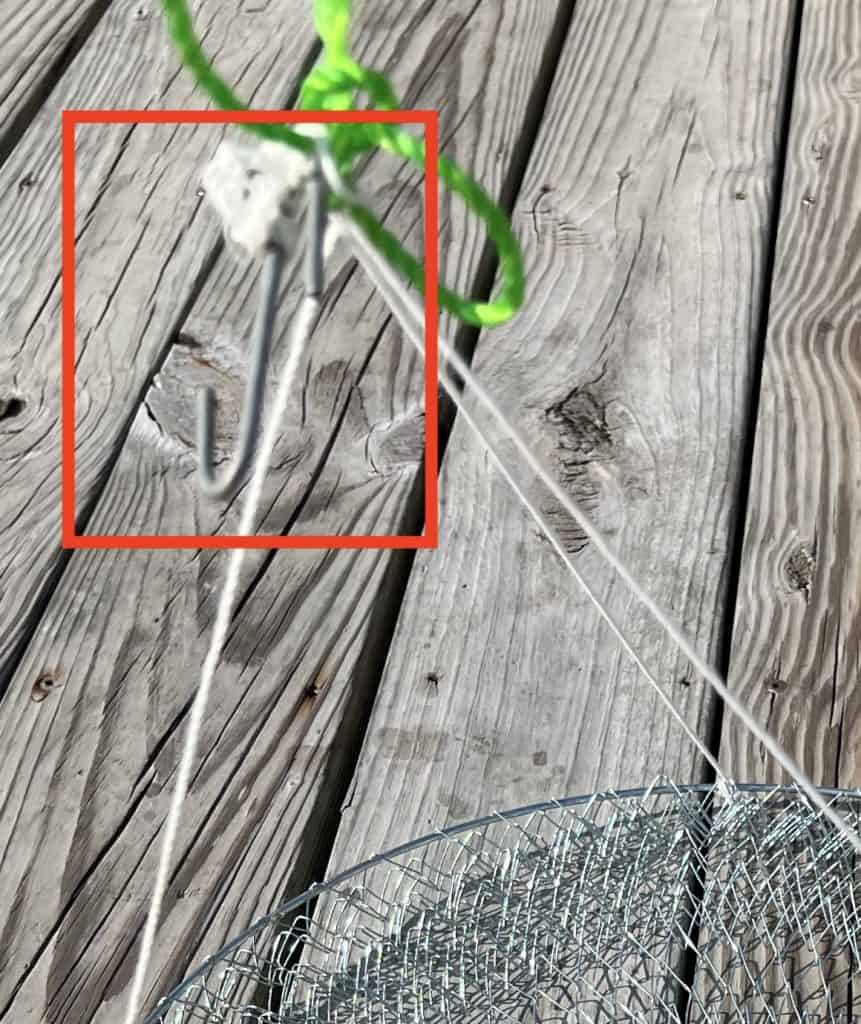
Step 3) Add your preferred bait to the center of your net.
Baiting your ring net is pretty simple, depending on what bait you use. Your bait should be secured in the center of your net. If you plan on using chicken or fish, I recommend using a zip tie, string, or whatever you have at your disposal to secure the bait.
I used the S hook that came with my ring net to secure a few chicken necks to my trap.
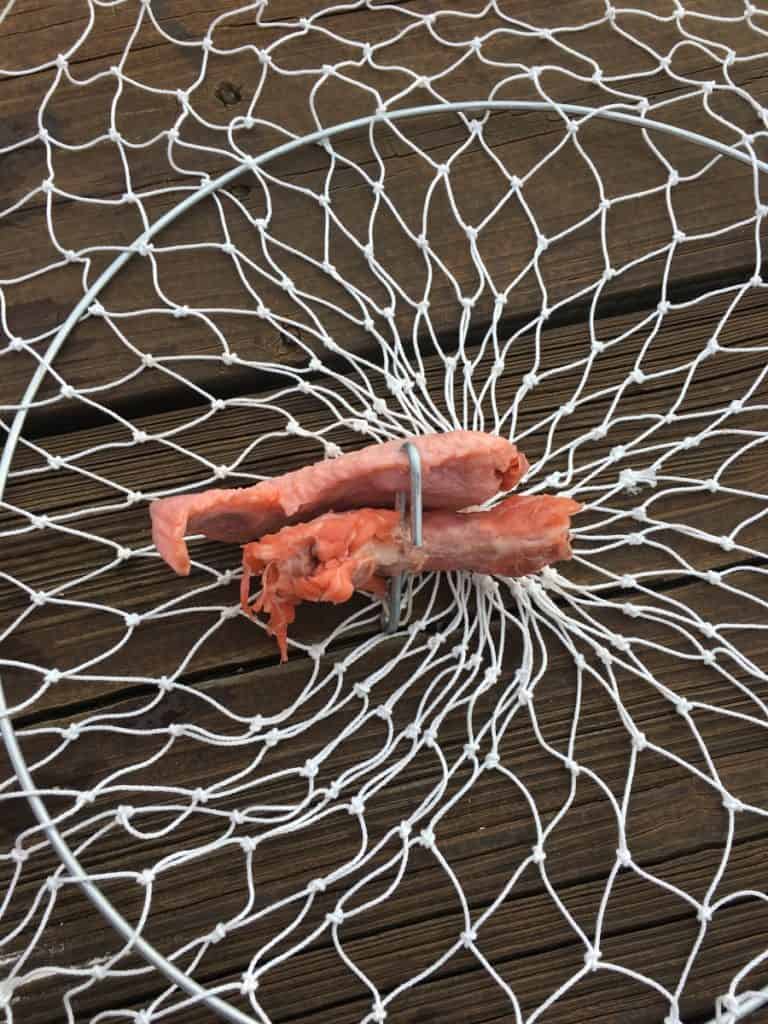
You can also use a bait box to hold your bait. You simply add your preferred bait and use a few zip ties to secure the box to the center of your net. This is a method because it adds weight to your net to prevent drifting, and holds more bait than a simple zip tie or string. You can find high-quality bait boxes on Amazon or
Step 4) Master the technique of pulling your ring net.
Now that your bait is secure in your net and you have a well-tied bowline knot around the end of your harness, you’re almost ready to throw your net in the water.
Find a nice dock over 4-20 ft deep waters with crabs (obviously). You will need a pole, or anything sturdy enough to tie the end of your line to. This is just in case the current decides to pull your net away.
Once the end of your line is secure, throw your crab net out into the water, clear of any obstacles it could get caught on.
The best way to pull your traps is with a quick, jerking motion while keeping constant tension on the line. This will make your trap fold upwards, trapping any crab stuck inside. Look at the gif below for a demonstration.
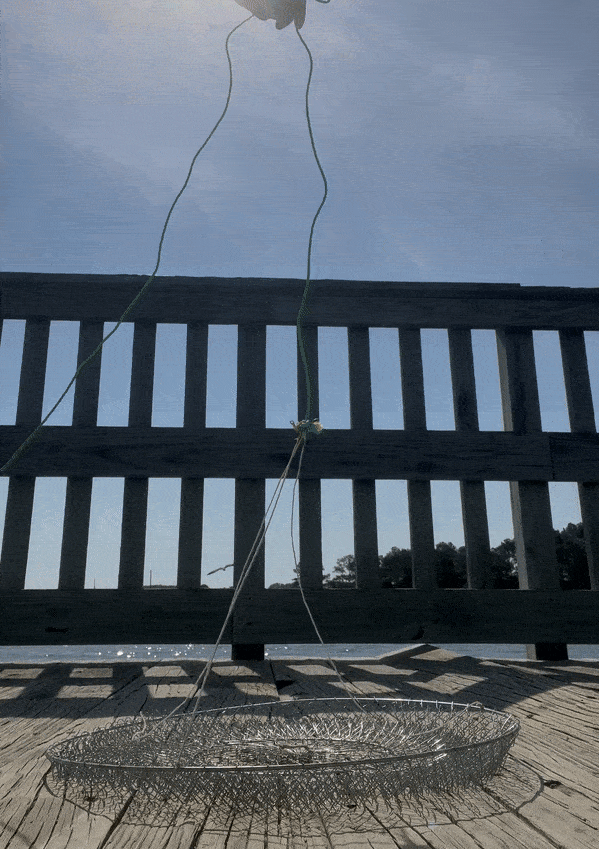
Bear in mind that you do not want to jerk your trap too quickly. This method will fling the crabs out of your trap. You want the quick, fluid motion depicted above. I recommend that you practice pulling your traps on land before crabbing.
I also want to point out that I was not slow with pulling this trap. Think of this from the viewpoint of a crab. If a wall of net mesh started forming around you, you would scramble to get out of that trap. If you pull too slowly, the crab may getaway. Quickly pulling the string, without jerking it, will form a nice net around the crab and prevent it from escaping.
After you set as many ring net traps as you like, or your state allows, it’s time to relax. I hope you brought a good book and a comfy chair. Set a timer and pull your nets every 8-15 minutes.
As you catch crabs, use tongs to transfer the crabs from your net to your cooler or bucket. Remember that some states have regulations on what crabs you can keep and eat. Check your local Department of Natural Resources for the latest, most accurate recreational crabbing regulations.

